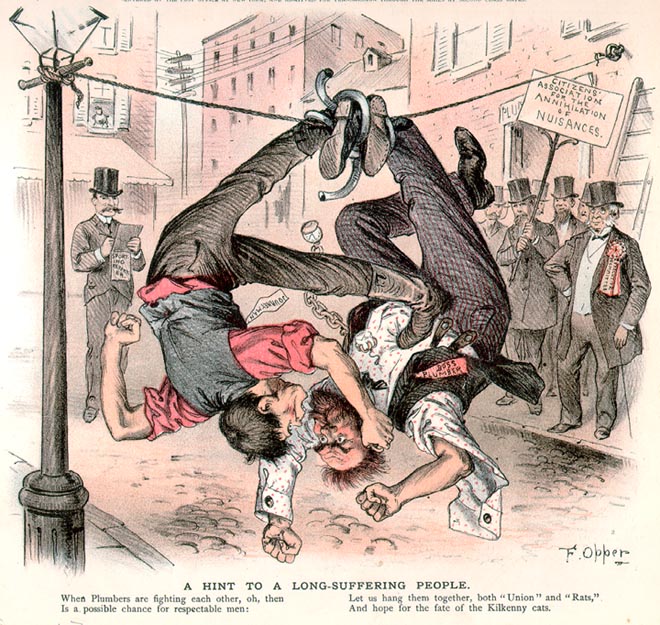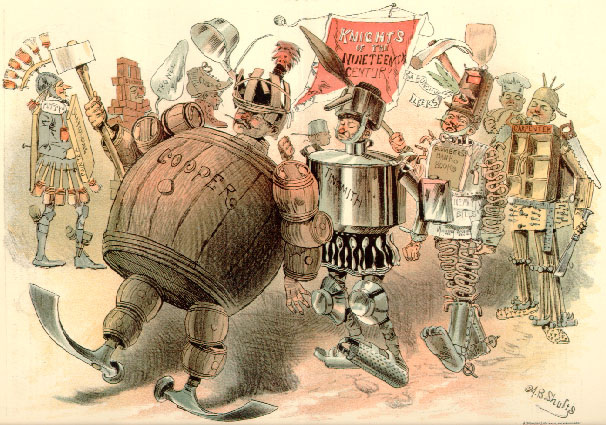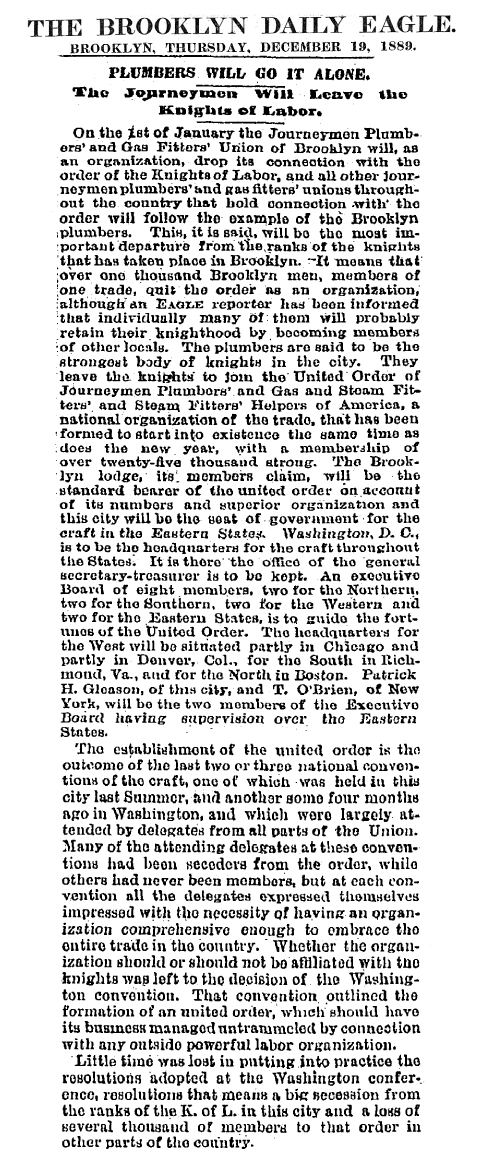The strike was a disaster, and in the end the Journeymen lost. They returned to work at the old wage, and the New York City Journeyman Plumbers Society was badly damaged by the strike. The general public was extremely upset and blamed both sides for the inconveniences the residents of the city had suffered during the strike.

During the 1882 New York City plumbers strike,
the news magazine PUCK published this political cartoon capturing the
feelings of the day (Note the red dots on the shirt of the Boss Plumber
indicating that he is only slightly advanced from the Journeyman in a red work
shirt, their legs tied together by lead pipe).
Following the unsuccessful
strike of 1882, the New York City Journeymen Plumbers Protective Society
decided to join up with the Knights of Labor. The Knights were a secret society
which had its roots in the labor movement of Philadelphia. They had formed initially
as a single craft union (garment cutters), but had adopted a philosophy of
uniting all labor in a broad union. By accepting members from other trades,
known as “sojourners”, they began to expand. By 1882 they were becoming a
rapidly growing national movement. Secrecy was initially a big part of their
rituals, and they were arranged in groups called “Assemblies”. The New York
City Journeymen Plumbers Society became Local Assembly 1992 of the Knights of
Labor. Affiliation with the Knights contributed greatly to the recovery of the
local, and a pay raise was negotiated without another strike. The grouping of
so many trades under one umbrella made business owners and some public
officials nervous, and encouraged negotiation rather than allowing a strike to
start. The Gas-Fitting trade was booming in these years, and while in New York
City the trades operated separate plumbers and gas-fitters local organizations,
in Brooklyn they had long been combined. The Brooklyn Plumbers and Gas-Fitters
Association subsequently joined the Knights with the assistance of the New York
Local Assembly 1992 plumbers.

A political cartoon of the time ridiculed the
Knights.
(Marcher #3 is the Plumber)
The 1880’s became a
period of great prosperity in the building trades, and by 1884 there
were in the New York City area five local assemblies of the Knights composed
solely of pipe trades craftsmen. The Steamfitters in New York City organized
themselves as the “Enterprise Association” in that same year of 1884 and shortly
joined the Knights as Local Assembly 3189.
Under the Knights, the
journeymen plumbers and gas-fitters in New York City and Brooklyn originally
flourished, adding new members and enjoying the prestige of being part of a
large national movement, but within a few years there was trouble. The plumbers
Local Assemblies were under the authority of District Assembly 49 which
comprised many crafts and mixed assemblies of Knights locals in New York City.
The plumbers felt that District Assembly 49 was not operating in the best
interests of the pipe trades. Under the Knights constitution it was possible to
organize district assemblies or even “national trade assemblies” of one
particular craft. The formation of a pipe trades craft assembly in New York
would save the local unions of plumbers, gas fitters, and steamfitters
considerable amounts of money which, instead of being sent to District Assembly
49, could be used for the furthering of interests of journeymen in the pipe
trades. Perhaps more importantly, it would also free the pipe trades locals
from the interference of the leaders of District Assembly 49.
They organized a
conference. The result was the formation of the “National Association of
Plumbers, Steamfitters, and Gasfitters” led by Patrick Coyle, a prominent
member of the New York City plumbers union. This was originally intended to be
a national organization within the Knights of Labor, perhaps to be recognized
as its own national trade assembly, but it was never sanctioned as its own
national trade assembly by the Knights. “The National” continued to operate
unofficially, organizing locals in several cities. By 1885 there was
confusion among the New York City plumbers.
Many had joined the
National Association, but still held membership under the Knights. The
situation came to a head when the leaders of the Knights, perhaps fearful of
losing the pipe trades altogether, granted an earlier request of the New York City
plumbers and Brooklyn plumbers & gas-fitters local assemblies to start
their own District Assembly. The new District Assembly 85 was a Knights of
Labor body composed of several unions of plumbers, gas-fitters, and
steamfitters which would no longer have to answer to District Assembly 49.
When the National
Association of Plumbers, Steamfitters, and Gasfitters held its annual
convention later in 1885, they concluded that the formation of District
Assembly 85 in New York proved that the Knights were never going to recognize a
larger national trade assembly of pipe trades, and voted to break with the
Knights, establishing an independent national trade union. With the inclusion
of some Canadian locals, they also changed their name to “International
Association of Journeyman Plumbers, Steamfitters, and Gas-fitters”.
A breakdown of unity
resulted, particularly in New York City. The I.A.J.P.S.G. grew in strength,
adding seventeen locals around the country throughout 1885 and 1886, but the
New York City and Brooklyn locals formally withdrew from the I.A.J.P.S.G. in
1886. The reason for this was that the membership of the New York City and
Brooklyn assemblies, all of them in District Assembly 85, refused to be
affiliated with an organization outside the Knights of Labor. They also had
been favorably discussing with the leader of the Knights, Grand Master Workman
Terrance Powderly, the upgrading of District Assembly 85 to a national trade assembly
within the Knights.
In June 1886 New York
City and Brooklyn received a charter from the Knights to set up a national
trade assembly. A preliminary convention was held in Brooklyn, and the new
organization was formally named the “United Progressive Plumbers, Steam and Gas-Fitters,
National Trade Assembly No. 85” of the Knights of Labor. Now there were two
national unions in the pipe trades.
1886 was turning out to
be the most critical year in the history of the plumbers union in New York. New
York City local assembly 1992 of the Knights of Labor called another strike.
This was an unusual strike because it did not center on wages or hours. The
only issue was apprenticeship rules; there was no disagreement on other
matters. The employers wanted complete control over apprenticeship. The union
demanded a ratio be established at one apprentice to four journeymen; on union
voice in acceptance of individual apprentices; and on union examinations for
apprentices to advance to journeymen. The 1886 strike dragged on for several
months and ended in complete union defeat. Local assembly 1992, which was the
core local of National Trade Assembly No. 85, was almost entirely destroyed. In
order to procure work, many members defected and organized a new local under
the I.A.J.P.S.G. This led to an all-out labor war, as former brother journeyman
plumbers, now in different locals under different national organizations,
battled for the same jobs in New York.
National Trade Assembly
No. 85 struggled on with the remnants of the New York plumbers local, the
Brooklyn plumbers & gas-fitters local, and the Enterprise Association
steamfitters in Local Assembly 3189 hanging together through 1887.
In 1888 the New York City steamfitters decided to quit National Trade
Assembly No. 85. They left to help found the “National Association of Steam and
Hot Water Fitters”. This additional blow to the Knights organization of pipe
trades in New York was severe.
The Brooklyn plumbers
& gas-fitters local was sticking together at home, but both of the national
plumbers unions were falling apart. The I.A.J.P.S.G. had gotten into financial
trouble and was struggling. As for the Knights of Labor, the whole organization
was in disarray. This was in part because of Terrance Powderly’s refusal to
allow “Trade Unions” to form within the Knights, and also due to devastating
strikes by Knights in coal mining and railroads.
There were still
feelings that somehow a strong international union of pipe trades could be
formed. The leaders of National Trade Assembly No. 85 began to correspond on
the issue. They contacted locals of the now bankrupt I.A.J.P.S.G., as well as
bigger independent locals like the Boston plumbers. A positive correspondence
between National Trade Assembly No. 85 secretary-treasurer Richard A. O’Brien
of Washington D.C., and Boston independent plumbers’ leader
Patrick Quinlan, encouraged the Brooklyn based leadership
of National Trade Assembly No. 85 to call for a meeting.
The meeting was held in
Brooklyn, July 29 through 31, 1889, and delegates were invited from all the
locals of the I.A.J.P.S.G., National Trade Assembly No. 85, and all the
independent unions known to exist. The meeting was attended by about a hundred
delegates. The discussions were favorable to the formation of a new single
international union to represent the pipe trades. They elected an executive
committee of three representatives; one representative from National Trade
Assembly No. 85, one from the I.A.J.P.S.G., and one to represent the
independent locals. This group of three then scheduled the founding convention
of what would become the “United Association of Journeyman Plumbers, Gas Fitters,
Steam Fitters, and Steam Fitters’ Helpers of the United States and Canada” or
the “U.A.”.
They set the date of
that meeting for October 7 through October 11, 1889 in Washington D.C., and in
accordance with the instructions given during the Brooklyn meeting, each local
was entitled to send one delegate for one hundred members or less, and one
additional delegate for each majority fraction of one hundred members. In the
Brooklyn Daily Eagle of December 19, 1889 there is recorded the following:

At the 1889 “Founding
Convention” of the United Association, the Brooklyn delegates were very
influential, since most of the founding locals were members of the Knights of
Labor National Trade Assembly No. 85, which Brooklyn had been running since the
devastating New York City strike of 1886. Brooklyn also had more members, and
more delegates than any other local represented. The Brooklyn local became
Local No. 1, and New York City was designated as Local No. 2. The date now
recognized as the founding of the United Association was the final day of this
convention, Friday, October 11, 1889.
The delegates from the Brooklyn and New York
City plumbers’ locals at the 1889 “Founding Convention” of the United
Association were as follows:
D. Cassin – Brooklyn, James Rankin – New York, T. Kinsella – New York,
P.H. Gleeson – Brooklyn,
H. Fox – Brooklyn, D. Hodgens – Brooklyn,
M.J. Driscoll – Brooklyn,
M.F. Murray – New York (Gas Fitters),
John Todd – Brooklyn, M.F. Dolan – Brooklyn (Eastern District) - Williamsburg
For the most part, the
Steamfitters did not participate, because they were still trying to set up
their own national union known as the “International Association of Steam and
Hot Water Fitters” or the “I.A.”. Not one local made up solely of steamfitters
actually joined the United Association at the “Founding Convention” of 1889.
The United Association held its next convention in Pittsburgh in 1890.
The delegates from the New York plumbers’
locals at the 1890 “First Annual” United Association Convention were as
follows:
James J. Doody – LU1, Augustus Esser – LU1, John Hand – LU1,
Michael Driscoll – LU1, James F. Hickey – LU1, John J. O’Connell – LU1,
William J. Carey – LU2, Edward Farrell – LU2, William W. O’Keefe – LU2,
James Laverty – LU6, William Till – LU6, (Note: LU6 – Brooklyn East)